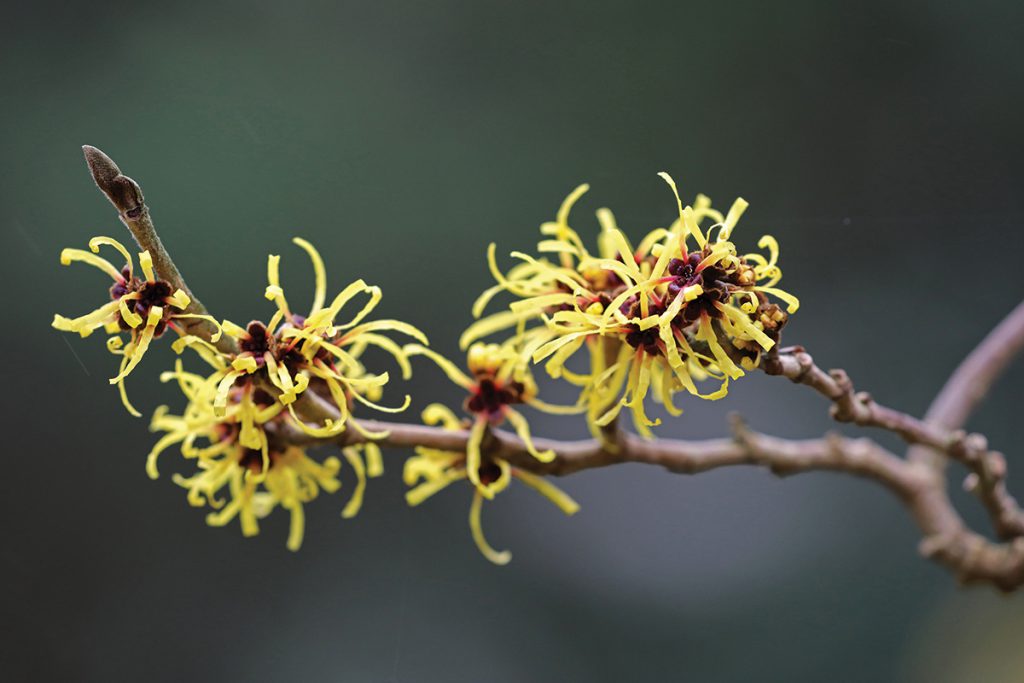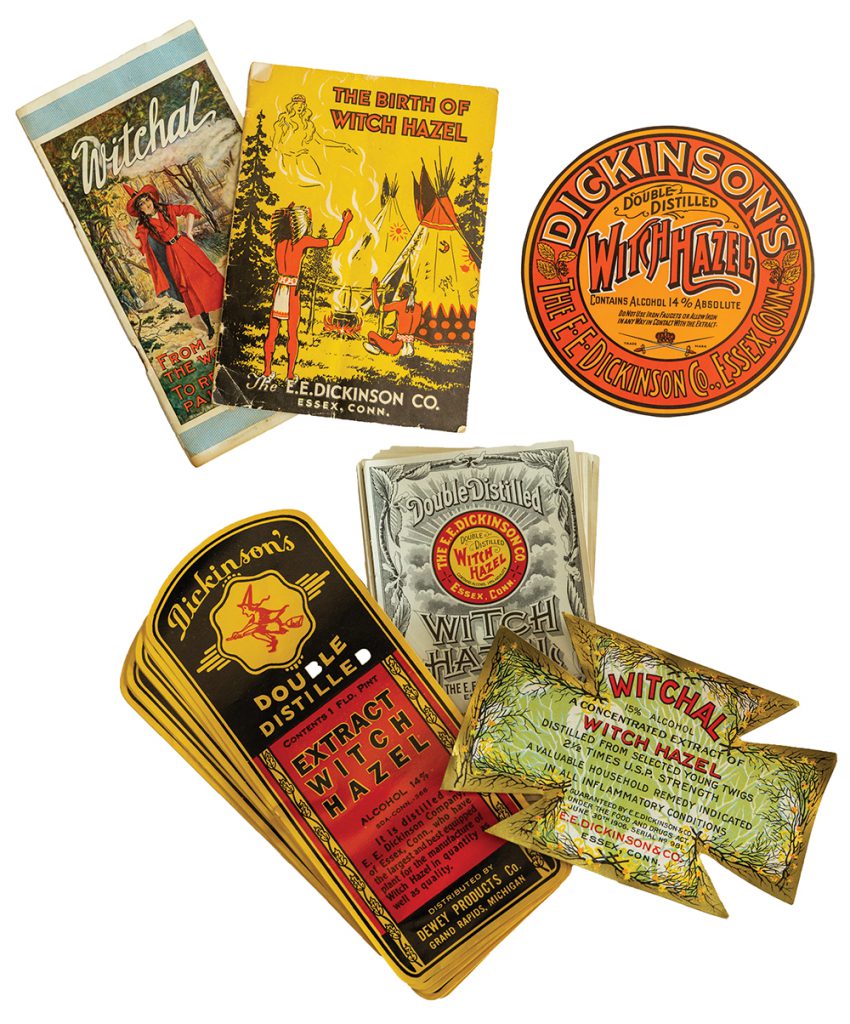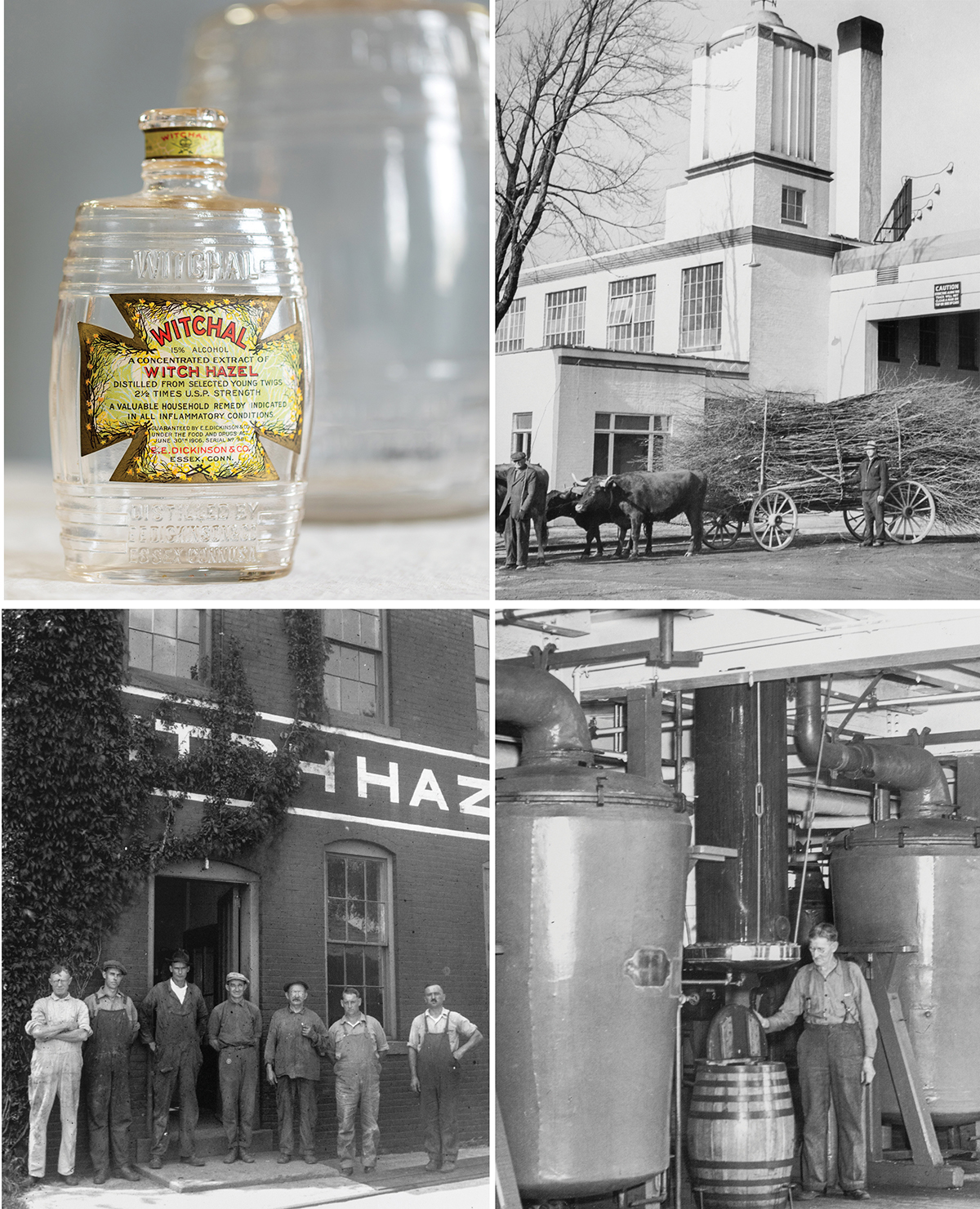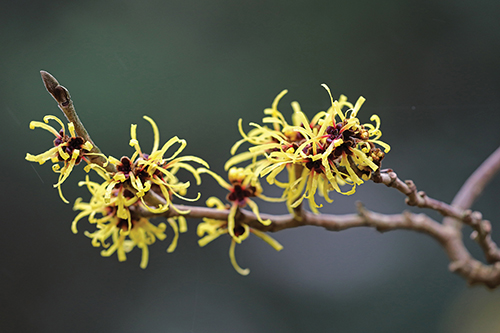
Witch hazel. Image Credit: Getty Images, Anolis01
Walking through the Connecticut River Valley woodlands in the autumn, you might happen upon a large understory plant with gentle golden star-flowers and few leaves, a strange anomaly this late in the year. This is witch hazel, sometimes called spotted alder or winterbloom, and grows throughout New England, appearing to be a large, irregular shrub or small tree. It is beautiful, but also useful, in a way that most of us have forgotten in these times of artificial chemical compounds and gene therapy.

The E.E. Dickinson Co. heavily marketed their witch hazel products and commissioned advertising photographs frequently. The “Mad Men” of Madison Avenue’s advertising heyday in New York City developed prominent marketing campaigns in the mid-20th century. Image Credit: Zoltan Farkas/From the collection of Essex (Conn.) Historical Society
If you have heard of witch hazel at all, you might have heard of its Y-shaped sticks being used to dowse for well water. The name is actually likely to have begun as “wych,” an Anglo-Saxon word for “bend.” But the plant is also one of many natural remedies that our ancestors knew and treasured, and today has become a vital part of our medicine cabinets without most of us ever knowing it.
Native Americans boiled the twigs and bark of this plant into a clear liquid that smelled delightful and acted as a natural astringent. They used it to treat skin problems and insect bites, as well as drinking it as tea for minor illnesses. Colonial farmers often planted a stand of witch hazel on their properties, and distilled it for sale at market. In the early 19th century, Dr. Alvin Whittemore of Essex first combined the extract with a 14 percent mixture of natural alcohol, allowing it to be preserved in bottles for multiple uses.

Witch Hazel marketing pamphlets and labels.
Image Credit: Christopher Zajac
Then, just after the Civil War, a minister and clothing mill owner named Thomas Newton Dickinson pioneered the commercial harvest and manufacture of this extract. His sons and grandsons split into rival Connecticut companies that produced the majority of the world’s supply for the next hundred years, using startling yellow and black advertising and taking advantage of society’s rising interest in clear, smooth skin.
In the late 20th century, this process was modernized and perfected by the East Hampton, Connecticut-based American Distilling, which cornered the global market. After all the leaves have fallen, harvesters with small chainsaws stalk the forests throughout the winter months, cutting these plants down near the base and delivering them in large trucks to the Connecticut factory. But not to worry, this sustainable crop will grow again from the same spot, and in seven years will be large enough to harvest again. The leftover wood is used as mulch; there might even be some in your garden right now.
The company pulps, conditions, extracts, and processes millions of gallons of natural, triple-filtrated distillate of witch hazel. This is used in a startling number of products you keep in your bathroom, including toners, cleansers, and hair products. Look through the ingredient lists and you might find it in a facial mask, after-shave gel, or suntan lotion. It has also been approved by the FDA as a skin protectant and anorectal treatment.
This soothing, refreshing solution is used as an additive by the world’s biggest and most prestigious brand names, from Procter and Gamble to Johnson and Johnson, from Clinique to Tom’s of Maine. Or you can go straight to the original source with Dickinson Brands skincare products.
It is not only the pores in our skin that are healed by this remarkable plant. “I love to be reminded of that universal and eternal spring when the minute crimson-starred female flowers of the hazel are peeping forth on the hillsides,” Henry David Thoreau wrote on October 27, 1853, “when Nature revives in all her pores.” It remains a symbol of hope, a last light before the winter darkness, a reliable, comforting salve from our shared past that we can take with us into an uncertain future.

Top Left: A pair of E.E. Dickinson product bottles in the collection of the Essex (Conn.) Historical Society. Top Right: Ed Palau and his father deliver large bundles of witch hazel trimmings to the E.E. Dickinson Co. factory in Essex, Connecticut, by ox drawn cart and truck in this photo from 1942. Farmers heavily trimmed native witch hazel plants in the early winter. The witch hazel shrub, a vigorous grower, could be trimmed and harvested once every five to seven years. In 1913 Dickinson paid $3.50 per ton of witch hazel brush. Bottom Left: Workers pose in front of the E.E. Dickinson factory in this photo from the early 20th century. Bottom Right: A worker poses among the large stills inside the E.E. Dickinson Distilling factory in 1942.
Images from the collection of Essex (Conn.) Historical Society

